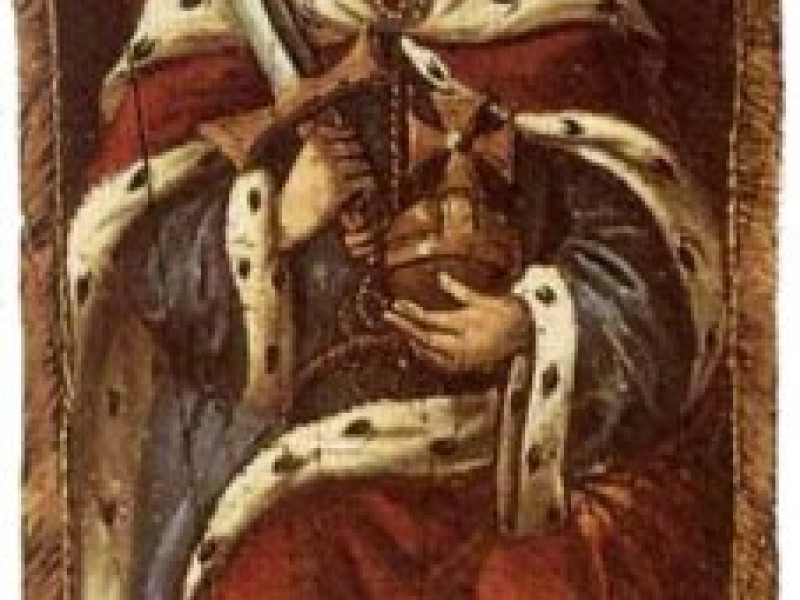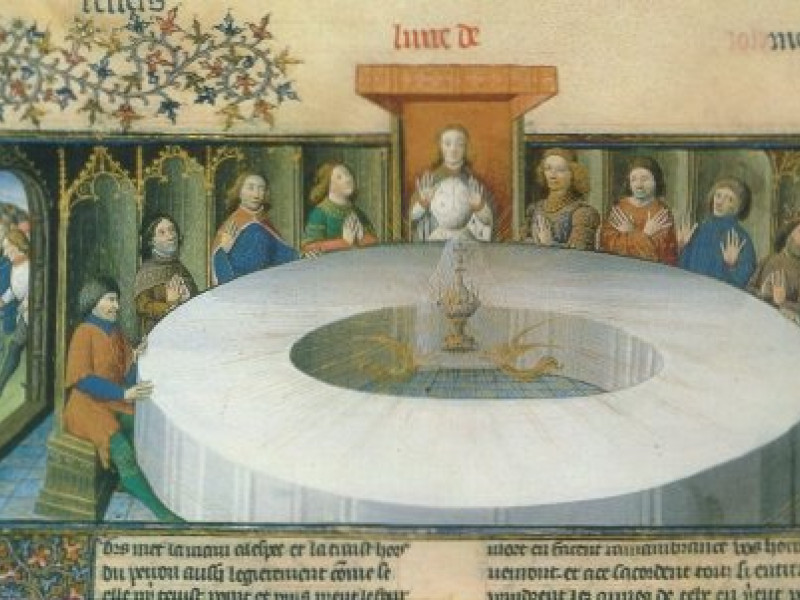Life of Charlemagne
Charlemagne was a historical figure, a king that emerge from the Dark Ages in Western Europe, giving rise to the early feudal period. However, the small numbers of historical records that survived, were enough to create a legend of a warrior king.
Here, we look into his character as both a historical and a legendary king, before giving a historical background on his life.

Charlemagne, the Legend
King of the Franks. Charlemagne, which means Charles the Great (Carolus Magnus in Latin), was mainly known as Charles I. Charlemagne was both a historical and a legendary figure. There are several areas in which the legend contradicts the historical Charlemagne. Even the historical accounts may exaggerate Charlemagne's achievements, which the Chanson de Roland and other epics certainly did.
He was the son of Pepin III, or Pepin the Short. In the legend, there was no mention of his brother, who was Carloman in history. His sister was unnamed in Chanson de Roland, but Einhard, Charles' biographer, called her Gisela.
As to his children, only his son Louis was mentioned in the legend.
According to the legend, from his sister's first husband, who was also unnamed, she was mother of the hero, Roland. When her husband died, she married again, to Ganelon, the chief villain in the Chanson de Roland, because he sought the hero's death. Ganelon and Charlemagne's sister became parents of Baldwin. This differed from the historical account given by Einhard, who listed Charlemagne's sister, Gisela, taking a vow to become a nun, so she didn't have any husbands, let alone two sons, one from each husband.
Judging by Einhard's account, Charlemagne didn't become the Holy Roman Emperor until he received this title at the hand of Pope Leo III on Christmas Day of AD 800. But the legend, particularly the Chanson de Roland, often referred to him as emperor during Charlemagne's campaign in Spain, which took place in AD 778.
Although Einhard briefly mentioned what happened with Roland in Rencesvals (Roncesvalles), the biographer made no mention of the Archbishop Turpin of Reims or other members of the Twelve Peers. There was also no mention that Roland was the king's nephew. To read more about the historical background of this battle, see Song of Roland, Historical Background.
During Ganelon's emissary to Marsile, in the Chanson de Roland, the Saracen king thought that Charlemagne was turning over 200 years old, which was of course, an exaggeration of the poet. The real Charlemagne would have been only 36 in age at the time of Spanish expedition.
The legend mentioned Charlemagne being a fair and kind ruler, which may have some truth. At other times, Charlemagne was shown to be indecisive, particularly in regards to sending an emissary to Marsile and during the trial of Ganelon.
Like the historical king, Charlemagne was very religious, and his religion was Christianity. Several times, Charlemagne had visions and angelic visitations from St Gabriel on behalf of God. When he captured Saragossa, he gave the people a choice of converting to Christianity or risk being put to death, either by hanging or burning. Historically, the real Charlemagne gave a similar condition to the pagan Saxons in the expedition of 775–777.
The legend showed him as a very powerful warrior. His sword was called Joiuse and his shield, he received from the town Viterbo. Charlemagne won his horse, Tencendur, when he defeated and killed Malpalin of Narbonne at the ford.
In the battle against Baligant, he killed King Canabeus, Baligant's brother, and later he killed the old emir himself.
Related Information
Name
Charles.
Charlemagne,
Carolus Magnus (Latin),
Charles le Grand (French),
Karl der Grosse (German)
– Charles the Great.
Related Articles
Historical Charlemagne
Charlemagne (AD c. 742 - AD 814) was the son of Pepin III, who was also known as Pepin the Short. He was the brother of Carolman and Gisela.
Originally, Pepin was a Mayor of the Palace for the dynasty known as the Merovingians. The Mayor of the Palace was an office that exercised great power, sometimes to the point where the mayors had more power than the kings. Pepin was no different. Pepin crowned himself as king of the Franks in AD 751. Pepin started a new dynasty, known as the Carolingians.
At Pepin's death in AD 768, the kingdom was divided into two for Charles (Charlemagne) and Carolman, but rivalry between two brothers escalated into conflict, and only ended at Carolman's death in 771. Thus, Charles became the sole ruler of the Franks.
Although Charlemagne was often seen as a wise and fair ruler, the truth of the matter can be seen in his handling of his rivalry between him and his brother, and later with him against Carolman's sons. They were never seen again, when he captured the Lombard city of Pavia. He clearly had royal ambitions, especially when he became king of Lombardy.
Charlemagne became involved in a series of campaigns or wars to expand his kingdom. He fought in the war against the pagan kingdom of Saxony (772-777). When he finally received their surrender, he forced the Saxons to become Christians or else they would be put to the sword.
In 778, he entered Spain, apparently to help a Moorish king to end an uprising there. But he failed to capture Saragossa, and returned to France. His rearguard was ambushed at Rencesvals (Roncesvalles). They were attacked by Gascons and Basques, not Saracens. Einhard only listed among the dead: Anselm, Count Palatine; Eggihard, the King's steward; and Roland, Lord of the March of Brittany.
Charles had to quell a rebellion among the Saxons, and he executed over 4000 Saxons as an example in 782. There were sporadic rebellions over the next 22 years.
Not even his cousin was safe. Charles overthrew Duke Tassilo of Bavaria, the same cousin who aided Charles against Carolman. He conquered other German kingdoms and annexed them into his growing empire. Charles also fought against the Slavs, Avars (Huns) and Danes.
One of his sons, Pepin, plotted against Charles during his campaign against the Avars. When this conspiracy was uncovered, he forced his son to take up a monastery life.
It was Charles who helped the Roman church to break away completely from the church of the eastern Byzantine Empire. As a result, when he went to Rome, Pope Leo III crowned him as the Holy Roman Emperor. It wasn't until 812 when Michael I recognised Charles as Emperor of the West.
With Louis being his only surviving son, he named him as co-ruler in late 813. At Aachen, Charles died at the age of 72, in 814.
Related Information
Sources
The Life of Charlemagne was written by Einhard (c. 833).
The Life of Charlemagne was written by the Monk of Saint Gall (c. 883).
The History of the Franks was written by Gregory of Tours.
Related Articles
By Jimmy Joe






